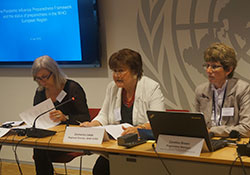Pandemic Influenza Preparedness (PIP) Framework

WHO
International Health Regulations Review Committee (2011)
The "Pandemic Influenza Preparedness Framework for the sharing of influenza viruses and access to vaccines and other benefits" (PIP Framework) brings together Member States, industry, other stakeholders and WHO to implement a global approach to pandemic influenza preparedness and response. It aims to:
- improve the sharing of influenza viruses with human pandemic potential; and
- achieve more equitable access for Member States in need of pandemic vaccines and medicines used in a pandemic.
Background
The first pandemic of the 21st century, the 2009 influenza A(H1N1) pandemic, clearly illustrated the need by individual Member States for equitable access to vaccines, antivirals and other pandemic response supplies.
The International Health Regulations Review Committee therefore declared in 2011 that "the world is ill-prepared to respond to a severe influenza pandemic or to any similarly global, sustained and threatening public-health emergency".
Adoption
Over a period of 4 years, Member States, with Secretariat (WHO) support, worked through an intergovernmental process to develop a unique Framework that covers the sharing of influenza viruses with pandemic potential and fair and equitable access to benefits arising from such sharing. This (PIP) Framework was unanimously adopted by the Sixty-fourth World Health Assembly in May 2011.
Structure
The PIP Framework is built on 3 fundamental pillars: virus sharing, benefit sharing and governance.
Virus sharing: Member States share "influenza viruses with potential to cause human pandemic" through the Global Influenza Surveillance and Response System (GISRS). Virus sharing gives rise to certain benefits and facilitates global preparation for the next pandemic, particularly through assessment of pandemic risk and development of pandemic vaccines.
Benefit sharing: Through the Partnership Contribution (PC) mechanism, influenza vaccine, diagnostic and pharmaceutical manufacturers using GISRS – make annual cash contributions to WHO for improving pandemic preparedness and response. Until 2017, 30% of all contributions received will be reserved for response to the next pandemic and 70% will be used to strengthen pandemic preparedness. Benefit sharing also occurs through special contracts with manufacturers that provide access to in-kind products needed for pandemic response.
Governance: Implementation of the PIP Framework is overseen by the World Health Assembly, the Director-General and the independent "Advisory Group" that advises the Director-General on the functioning of the Framework and its implementation.



